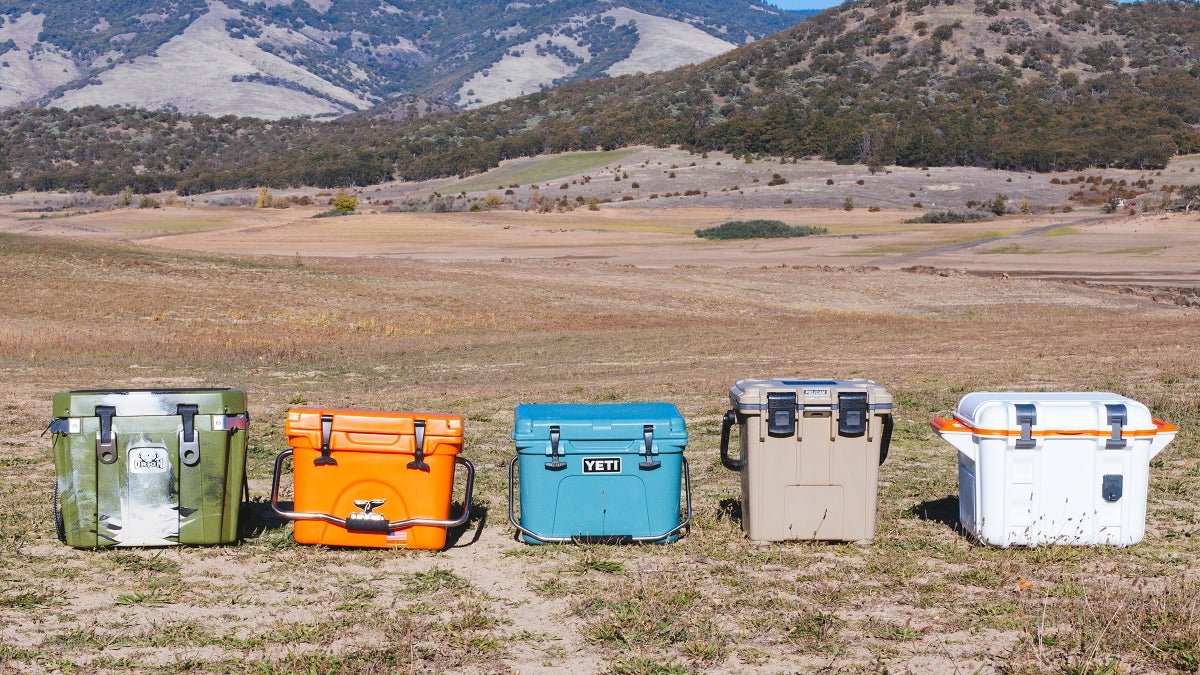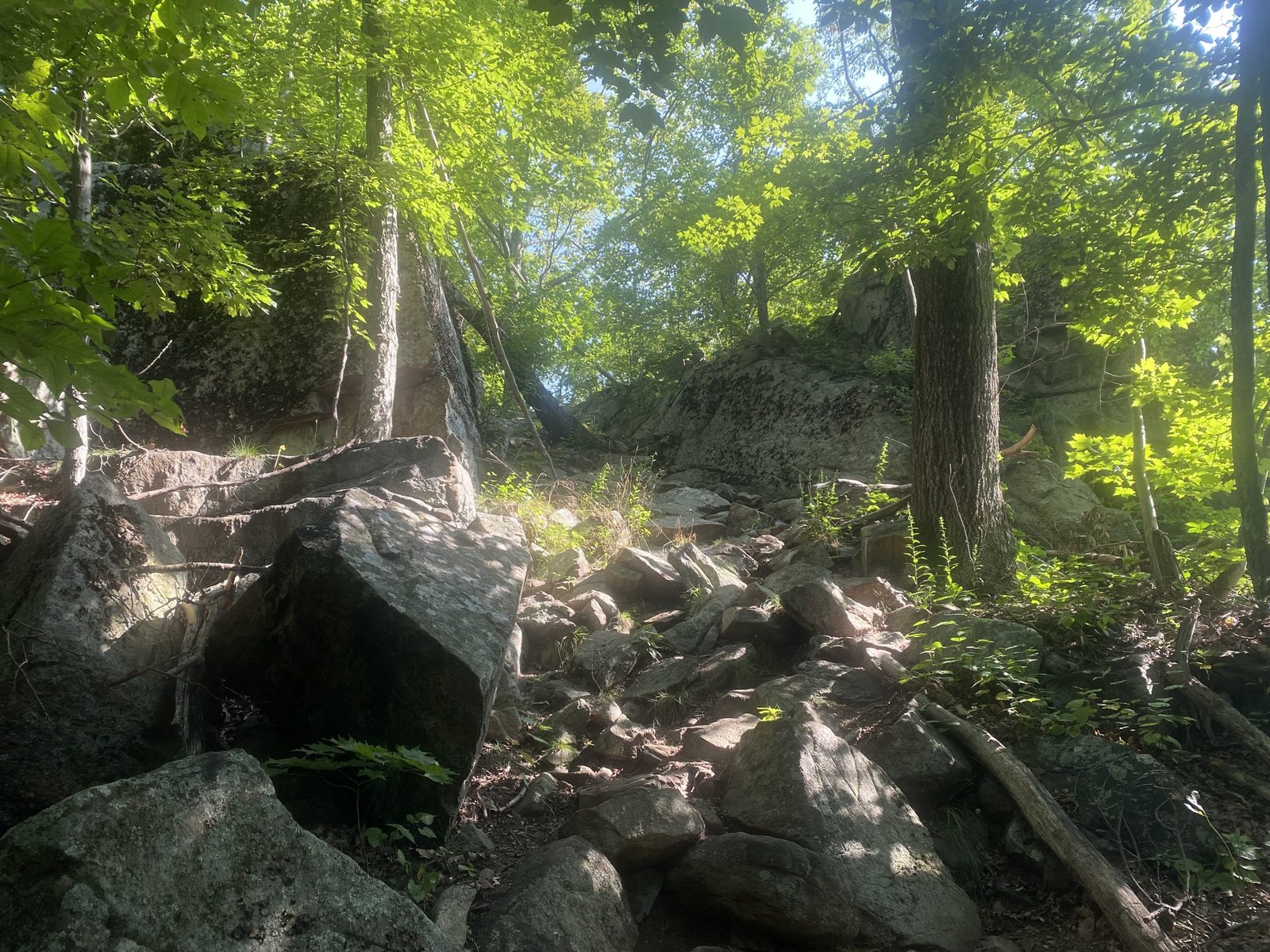Destinations & Things To Do
The 6 Best Hard Coolers for Camping, Boating, and Fishing (2025)

Coolers are the gastroenterological core of every camping trip. If your cooler fails, your drinks are only lukewarm and your perishables go bad. While ice retention, exterior durability, and interior capacity are all important features to consider, we also think the devil is in the details when it comes to buying the right cooler. A massive amount of insulation won’t do you any good if the clasps don’t seal it closed, and spaciousness doesn’t matter if you can’t find things or carry it. After months of testing, here are the six best coolers for car campers, vanlifers, and beach bums.
Watch: How to Choose a Cooler
Best Coolers: At a Glance
Best Overall
Yeti Roadie 32 Wheeled Cooler
External Dimensions: 16” x 18” x 21”
Capacity: 32 L
Weight: 24.5 lbs
Score: 9.5/10
Pros and Cons
⊕ The most portable cooler of our test
⊕ Retained coolness beyond testers’ expectations
⊕ Took months of beating with aplomb
⊗ Tall height means it has to be packed thoughtfully
For as much as we didn’t want to deliver yet another win to Yeti, it felt like betting with the house. We could not ignore how well the Roadie 32 Wheeled Cooler performed in every aspect of our test, and it became my family’s favorite cooler for five months of adventures. This model is a smaller, upgraded version of the Roadie 48 Wheeled Cooler, which we also tested and loved. While testers initially questioned why a 32-liter cooler needs wheels, they quickly realized the benefits. Five-inch-diameter, off-road-capable wheels made navigating rough terrain manageable. We also appreciated the 26.5-inch-long telescoping handle—five inches above the height of the cooler—which made it easy to maneuver even when the cooler was fully loaded.
As for the cooler body, it’s made out of Yeti’s famous rotomolded polyethylene that came away without damage after months of consistent hard use transporting perishables around campsites and being errantly left outside for months. The footprint of the base is slightly smaller than the lid, which, coupled with the taller height (to accommodate wine bottles), packed neatly into a variety of vehicles. On the thermoregulating front, the pressure-injected polyurethane insulation kept an entire cooler’s worth of food satisfactorily cold with only a Yeti Blue Ice pack tucked inside for two full days with highs over 102 degrees—far outperforming our expectations of a cooler only chilled with an ice pack. Plus, the single drain plug never leaked.
Best for True Connoisseur
Snow Peak Hard Rock 40-Qt Cooler
$454 at Backcountry $648 at Snowpeak
External Dimensions: 25″ x 16″ x 15″
Capacity: 38 L
Weight: 25 lbs
Score: 9/10
Pros and Cons
⊕ Beautiful design
⊕ Thoughtfully built to last forever
⊗ Expensive
The Hard Rock 40 is a collaboration between two brands with sterling reputations: Grizzly Coolers’ products are bomb proof, and Snow Peak’s Japanese aesthetic is sleek. The result is a cooler so sexy that four testers did not even bat an eye at the eye-watering price. The bear-proof rotomolded cooler easily kept our perishables cold on a four-day camping trip in California’s North Coast, retaining about 80 percent of the ice block in temps with highs in the 70s.
Testers noted that the Bear Claw Latch System rubberized closures, which wrap over and around rectangular knobs to lock down the cooler, made the cooler impossible to unintentionally crack open and let air out when closed down. Those closures also look cool as hell with contoured edges and a low-profile design that integrates seamlessly with the cooler body. Its matte finish and subtle, claw-like silhouette give it a tactical-meets-minimalist look that’s both tough and sleek. Not only does this closure design make the cooler virtually impervious to animals without prehensile fingers, it makes it easy to latch and unlatch with one hand. The drain plug is just as easy to crank open and closed. Like the other premium coolers in this category, it is rotomolded with a hefty serving of polyethylene, which makes it impervious to the beating we delivered during months of car camping and gives it lifelong durability.
Best Value
Igloo ECOCOOL Latitude 52-Qt Cooler
External Dimensions: 25″ x 15″ x 15″
Capacity: 49 L
Weight: 9.8 lbs
Score: 7/10
Pros and Cons
⊕ Good bang for your buck
⊕ Sustainable materials
⊗ Not as insulating as the other coolers on this list
⊗ No drain plug
The ECOCOOL Latitude 52-Qt cooler proves that there is still space for a low-tech cooler in a market dominated by $400 beasts that hold onto ice for weeks. For $60, the ECOCOOL did a respectable job of keeping snacks and drinks cold during a 60-degree weekend of camping in Oregon’s Siskiyou Mountains. Would we want to depend on it for a multi-day river trip? No. But that isn’t what this cooler is designed for. Rather, this cooler is made for more casual car camping. Testers reported that the handles didn’t bend under a 50-pound load, and the lid’s solid hinge and sturdy clasps added to its potential longevity. As a bonus, the ECOCOOL is made from post-consumer recycled resin. One feature we would’ve liked to see: A drain plug.
Best for Boaters
Bote Kula 10
External Dimensions: 24” × 15″ × 19″
Capacity: 38 L
Weight: 24 lbs
Score: 7.5/10
Pros and Cons
⊕ Rounded sides packed well into crowded boats
⊕ Top holds two cans steady on rocking boats
⊗ Does not play well with ice blocks
⊗ Handle is too big for packing tightly
Boaters notoriously pack a lot of drinks (usually beer), and the Bote Kula 10 has the capacity for quenching their thirst. “This cooler was built to party,” reported one tester, who found the included bottle opener easy to use and appreciated the magnetic aluminum can holders while rowing down a Class II stretch of river. Teetotalers, on the other hand, found the bottle opener to be a little much. Cylindrical beverages, such as cans of beer or bubbly water, packed efficiently against the interior’s rounded corners. Those same rounded corners on the exterior helped it squeeze into the rarely square, open spaces of the 13.5-foot Sotar Raft we tested it in. The only downside of the rounded body was it did not play well with blocks of ice that typically tuck beautifully into the corners of classic square coolers. This posed a problem on our hottest camping trip on the Klamath River, in which bags of crushed ice didn’t stand a chance against triple digit temps.
Best Braun for the Buck
RTIC 65 QT Ultra-Tough Cooler
External Dimensions: 31.62” × 17.5” × 17”
Can Capacity: 84 Cans (No Ice)
Weight: 38 lbs
Score: 8.5/10
Pros and Cons
⊕ Incredible durability throughout
⊕ Smart accessories
⊗ So heavy
With an admirable 3 inches of foam built into the body, the Ultra Tough held its own in terms of ice retention against similarly-sized and rotomolded Yeti coolers but at a more affordable price point. We were also impressed with this cooler’s padded rope handles, which allowed for comfortable carry even when filled with a family of three’s food and drinks for a weekend camping trip. Every tester agreed that having two drain plugs was a significant bonus for both removing excess water and cleaning. It drained two blocks’ worth of melted ice in under five minutes and removed enough of the water that we only had to wipe it with a washrag upon our return. Non-skid feet added a little extra traction when loaded into the back of a truck.
At more than $200, this RTIC cooler is still not cheap, but it’s $150 less than its Yeti counterparts and has a solid chance of lasting just as long thanks to durable design details, from the hardy clasps to the thick rope handles. One downside of all of that burl? At nearly 38 pounds empty, it was the heaviest cooler we tested—even heavier than one with a built-in refrigeration system.
Paid Advertisement by Backcountry.com
Canyon Coolers Pro 65qt Cooler
Looking for a cooler built to withstand a long and happy life filled with campsites, beaches, and backyard BBQs? Meet the Pro 65 from Canyon Coolers, a 66-quart ice chest featuring pressure-injected foam insulation with a durable rotomolded construction. This hard-sided cooler also features a divider that can be used as a convenient side table, oversized latches for secure closure, and oversized drain plugs for easy cleaning.
Best For Vanlifers
Dometic CFX-2 45
$880 at Backcountry $880 at Dometic
External Dimensions: 16” x 19” x 27”
Capacity: 45 L
Weight: 40 lbs
Score: 8/10
Pros and Cons
⊕ Really efficient
⊕ Can keep ice indefinitely with power source
⊗ Need access to power
⊗ Lid can make accessing food at bottom difficult
Built with integrated cooling systems, Dometic coolers are marvels of modern cooler science. Dometic’s game-changing, hyper-efficient electric coolers essentially invited mini-fridges into our vans, truck conversions, and even campsites—as long as you have a converter or generator to plug them in to. But what we love about the CFX-2 45 doesn’t have to do with electronics; it’s that it’s tough as hell. Our test model spent a vast majority of its time in the back of a 2020 Ford Transit, pulling double duty as a cooler and a step-stool for kids ranging from 35 to 65 pounds. We never had to worry about denting or cracking it. Credit goes to the reinforced corners, stainless steel hinges, heavily fortified plastic folding handles, and thick lid.
With the ability to connect to 12/24 volt car DC as well as 100-240 volt home AC, testers plugged it in at home before packing up the night before to maximize charge and coolness. Once on the road, it stayed plugged in at all times to retain cold air. Since the lid swings up from the top, rather than off the side, testers noted that food at the bottom can be tricky to reach. But that slight annoyance didn’t bother us too much during a two-week cross country trip. Our only real complaint is the $800 price tag, but it’s hard to even fault Dometic for that since the CFX-2 45 is essentially a portable mini fridge.
Cooler Comparison
| Cooler | Price | Score | Pros | Cons |
| Yeti Roadie 32 Wheeled | $375 | 9.5/10 | Most portable; retained coolness beyond expectations | Tall height requires thoughtful packing |
| Snow Peak Hard Rock 40-Qt | $648 | 9/10 | Beautiful design; built to last | Expensive |
| Igloo ECOCOOL Lattitude 52-Qt | $60 | 7/10 | Good bang for your buck; sustainable materials | Not as insulating; no drain plug |
| Bote Kula 10 | $331 | 7.5/10 | Packs well into crowded boats; top holds 2 cans steady | Does not play well with ice blocks |
| RTIC 65-Qt Ultra Tough | $242 | 8.5/10 | Durable; smart accessories | So heavy |
| Dometic CFX-2 45 | $880 | 8/10 | Really efficient; can keep ice indefinitely with power | Needs access to power |
Other Products We Tested
- Oyster Tempo Cooler ($445): This iceless cooler blew testers’ minds with how quickly it dropped in temps when we threw cold packs in it. But the stainless steel exterior proved susceptible to scratches and dings.
- Igloo IMX 70 Qt Cooler ($250): We loved this cooler’s hardy design details, like the metal rope handles; but in the end we decided the RTIC 65 was a better overall choice in this size and price class.
- RTIC 32 qt Ultra Light Cooler ($144): RTIC did a great job of lightening up this cooler while maintaining fantastic thermoregulation with its super deep, heavily insulated lid, but it did not perform as well in either ice retention or durability as its heavy duty RTIC counterpart that made this list.
Products to Avoid
Single Use Coolers: To be honest, coolers have traditionally been a pretty non-eco friendly outdoor gear category. Their plastic exterior and foamy plastic insulation does not have the best track record for the earth or the health of those who manufacture it. A case can be made that most coolers have some environmental blood on their latches. With that said, nothing is more wasteful than a single-use cooler. On top of going immediately into a landfill, they don’t really do anything in terms of insulating their contents either. They are both wasteful and pointless.
How to Choose a Cooler
What Size Cooler Is Best?
Pick a cooler that’s big enough for your average trip length. If you get a cooler that is too small, you will go hungry, but a cooler that is too big will create coolness-wasting dead space. Each trip is different and group size can change things, but as a very general rule of thumb, I like to bring a 20- to 45-liter cooler on day- to weekend trips for my family of three, and a 55- to 70-liter cooler on trips lasting three days to a week.
Do You Really Need an Expensive Cooler?
This is a really tough question to answer as an individual who is obsessed with fancy coolers but spent most of his life using the cheapest coolers available. The short answer? If you are a reasonable drive from a place with ice and are camping for a weekend, you don’t need a cooler that can hold a single block of ice for a fortnight. Is it a good investment to buy a durable cooler (usually an accompanying factor in a pricey cooler) even if you don’t need it to retain ice forever? Yes, I think spending some extra dough is worth it.
What’s the Best Way to Pack a Cooler?
A cooler is only as good at retaining ice as the person using it. If you have a $400 cooler built to keep ice solid through the entirety of a Grand Canyon trip, but you leave it wide open in the sun for an hour on a super hot day, you just robbed that cooler of its ability to keep its contents cold.
I could write another 2,000 words on cooler maintenance, but there are three main rules you should follow: One: Try to reduce the cooler’s temperature before your trip, and keep it in the shade. The heat of the cooler itself drastically changes performance. Two: Keep the lid shut as much as possible. That means grabbing food with purpose rather than rummaging around. It also means grabbing multiple things at a time, such as all your sandwich fixings, and then immediately closing the lid rather than opening it once for ham, once for mayo, and once for cheese. Three: If your cooler has latches, keep them tight after every opening.
How We Test
- Number of coolers tested: 12
- Number of testers: 12
- Days camped: 30+
- Meals eaten: 80+
- Days rafted: 6
- Trips to the beach: 10
- Number of coolers accidentally left in a side yard for 5 months: 1
We had an absolutely epic end of summer, fall, and early winter adventuring with these coolers, aiming to give them the most real world scenarios to see how they held up in the mountains, on beaches, and on rivers. Our group of 12 testers used them on five main testing trips in three states ranging in weather from blazing hot to frigid rain. While general durability, capacity, and ice retention are all extremely important factors, we also spent hours poring over the finer details like the handles, closures, and drain plugs to tease out the nuance of what made them worthy of this guide.
Meet Our Testers
Joe Jackson made a name for himself testing coolers during his first year working at Outside over a decade ago. Ever since he has been obsessed with the intricacies of closed cell foam, durable rotomolding, and keeping every goddamn lid closed to not let out all of the insulated air. His love of cooler testing and maintenance started during the ten years he worked as a raft guide and was solidified the year he managed a rafting company that cooked all of its meals out of food stored in coolers.
Sarah Jackson absolutely and utterly doesn’t fuck around when it comes to cooler packing and maintenance. She is the person everyone asks where the cheese is packed (even if it isn’t in her cooler) and has been known to move a cooler half a dozen times to keep it in the deepest shade on a hot campsite. She has tested, loved, and even destroyed coolers with her husband, Joe, for over a decade.
Zach “Red” Williams uses his 2020 Ford Transit and teacher’s schedule to maximize adventure for his family of four. He tested coolers for us on multi-week road trips, weekend camping trips, tailgating in ski resort parking lots, and rafting trips.
More Gear Reviews
The 8 Best Instant Coffees for Backcountry Adventurers
Yeti’s New Hondo Beach Chair, Tested and Reviewed
The Best Portable Camping Chairs for Fireside Lounging
Destinations & Things To Do
Dubai and Riyadh Becoming Top Travel Destinations in 2025 with New Attractions and Infrastructure: All You Need To Know Before Planning a Trip

Published on
August 9, 2025 |
With 2025 approaching the forefront of global tourism, particularly leisure travel, the focus seems to be on Dubai and Riyadh. Both of these cities are undergoing an infrastructural makeover along with the construction of new and modern leisure attractions to accommodate the rising number of tourists. Riyadh is in the regime of catching up due to its vast reforms and investments, while tourism and luxury travel in Dubai is long established.
This exciting development is not just about high-end hotels and impressive skyscrapers; it is about a shift in culture, business, and hospitality. Dubai and Riyadh tourism are becoming more dynamic, offering experiences that are both innovative and enticing for travelers worldwide.
Why Dubai Is Dominating the Global Travel Scene
With 2025 approaching the forefront of global tourism, particularly leisure travel, the focus seems to be on Dubai and Riyadh. Both of these cities are undergoing an infrastructural makeover along with the construction of new and modern leisure attractions to accommodate the rising number of tourists. Riyadh is in the regime of catching up due to its vast reforms and investments, while tourism and luxury travel in Dubai is long established.
The government of Dubai has strategically places major tourism infrastructure like Dubai International Financial Centre and Dubai Media City. Other businesses and creative industries have also set up offices in these areas which, along with new global attractions like Dubai Opera, Aqua Fun Park, and Dubai Safari Park, makes Dubai a must visit place for corporates and entrepreneurs looking to blend business and leisure.
The Dubai tourism policies have also evolved, with initiatives encouraging global partnerships and enhancing the visitor experience. The city’s commitment to sustainability and smart technologies ensures that its future in tourism remains promising and appealing to the growing eco-conscious traveler.
Riyadh: The New Rising Star of Middle Eastern Tourism
While Dubai’s evolution has been impressive, Riyadh is now catching up at an astonishing rate. Under Saudi Arabia’s Vision 2030, the capital city of Riyadh is being transformed into a vibrant global hub for business, tourism, and leisure. Vision 2030 has reshaped the city’s tourism and hospitality industry, focusing on the development of cultural landmarks, luxury resorts, and entertainment options that can rival cities like Dubai.
Riyadh has made leaps towards attracting international tourists. By 2025, Riyadh’s tourism infrastructure includes luxury hotels and unparalleled services of Four Seasons Hotel Riyadh at Kingdom Center and Mandarin Oriental Riyadh. Aside from the existing high-end hotels, modern cultural museums, art exhibitions, and even theme parks are under consideration which will augment demand and cater towards leisure tourism.
Saudi Arabia’s recent decision to lift alcohol restrictions in designated areas and host major sporting events signals its intentional pivot toward becoming a more tourism-friendly country. This shift, paired with large-scale investments in tourism infrastructure, makes Riyadh one of the most exciting places for tourists in the coming years.
The Competitive Edge: How Dubai and Riyadh Are Competing in Tourism
The rivalry between Dubai and Riyadh is heating up. Both cities are keen to dominate the Middle Eastern tourism market, and this competition is fueling rapid advancements in infrastructure and tourism policies. By 2025, Dubai was already the destination of choice for many corporates and leisure tourists. However, Saudi Arabia has introduced several new policies aimed at increasing the number of regional hubs in Riyadh.
The change in Saudi Arabia is one of the major economics Saudi Arabia. Riyadh isn’t only erecting new lavish hotels. Riyadh is setting up a new complete system for businesses, events, and recreational activities. In response, Dubai eased its business laws and started granting a number of incentives for foreign companies to establish regional offices there. This rivalry of industrial supremacy is for sure going to add a new layer in the already Dubai and Riyadh fueled innovation in tourism and increasing traveler’s opportunities in 2025.
The Future of Travel: Why You Should Visit Dubai and Riyadh in 2025
As the cities of Dubai and Riyadh strive to diversify and innovate, they are becoming more appealing to travelers. Dubai is a luxury travel destination, and with the new additions of mid-scale and affordable options, it is now accessible to all. Riyadh is emerging as the prime location which serves a dual purpose of business and leisure travel. With its strategic investments and rapid pace of development, it is going to be a tourist hotspot in the coming years.
Both cities now have sophisticated tourism infrastructures, offering modern transportation systems, attractive cultural events, and a growing number of entertainment options for travelers. Whether you’re visiting Dubai’s iconic malls or exploring Riyadh’s cultural renaissance, these two cities will continue to define the future of Middle Eastern tourism.
Key Takeaways for Travelers
- Dubai and Riyadh are poised to dominate the global tourism landscape in 2025 with new attractions, policies, and experiences.
- Dubai’s tourism scene is expanding beyond luxury to include mid-scale options and sustainable initiatives.
- Riyadh’s rapid transformation under Vision 2030 is making it a competitive alternative to Dubai for both business and leisure.
- As both cities compete for tourism dominance, 2025 will be a pivotal year for travelers looking for unique experiences in the Middle East.
Conclusion: Why 2025 Is the Year to Visit Dubai and Riyadh
With their ever-growing appeal to leisure travelers, Riyadh and Dubai are poised to be the ultimate destinations by 2025. Both cities are sure to stay at the top of travelers’ lists for years to come. This is thanks to their booming infrastructures, fuelled by а sustainable practices, new tourism experiences, and visionary policy investments.
Destinations & Things To Do
Day 94: Town Chores and Velvet Rocks

- Hanover Food Coop, NH (1756.7) to Trescott Road (1706.6)
- 1148 feet ascent, 748 feet descent
Today is a nero experiment. The Historian’s back hurts and he is still struggling with getting enough food to run his engine. With our Katahdin climb scheduled so soon, my my engine is running overtime. We decided to do errands in town and then The Historian will drop me off for a quick slack pack to pick up some of the disjointed bits and pieces we have not hiked in the gap between Hanover and Glencliff.
I missed this section in 1975 because The Historian had limited time for a visit with me. Either I could skip ahead to the start of the Whites, or he would have to miss the Presidentials. I decided to skip ahead for love. During the time we lived in Hanover in the 1990s, we day hiked some of the missing parts but not all of them. I am filling in the pieces now.
Morning Garden Patrol
We had another peaceful morning with our friends enjoying their multi-generational family life. One thing we particularly enjoyed is the early morning garden inspections.
A few years ago we had a large raised bed garden spread out along a .15 mile meandering path. Each morning we would take our coffee and our dog out for a lap through the garden. We have since downsized and have a small garden but we still enjoy morning coffee inspection of the garden.
Our friends have a large vegetable garden plot and multiple berry patches as well as flower gardens, fruit trees, and nut trees. Morning garden inspection made us think about our gardens past and future, and appreciate the slow and exciting process of food production.
Town Chores
After breakfast we made a list of our town chores. We have all of our meals already; they arrived in our mailed resupply. We needed to add some protien bars, rasins, m and ms, chia seeds, and protien drink. We knew we could find the very things we wanted from the Hanover Food Coop. We also needed more bug spray, available from the outfitters nearby.
The drive to town included passing over several bridges, two of them covered bridges. Even having lived in the area before, the novelty of covered bridges never wears off.
The light from inside the bridge is as much fun as seeing the bridge from the outside.
Hanover Coop
The Coop store on the Appalachian Trail is a lot smaller than I remembered. There is a large, modern supermarket version but I wanted nostalgia so we went to the original store.
The food selections were amazing, as always. It was hard not to over buy dramatically. We had some car days coming up so our over selection of food did not punish our backs.
When we got to the checkout, they asked if we were members. Low and behold, we were still in the member records from 1996.
A Snippet of Hiking
Town chores accomplished, we ate our Coop-acquired lunch in the car at the Dartmouth playing fields, literally parked on the Appalachian Trail.
After downing the last of my sparkling water, I tightened my shoe laces and took off. The Historian would drive to the next trail crossing and I would race to meet him, covering the short 4 miles as quickly as I could.
This would fill in one of the gaps and allow me to advance to the next non-contiguous needed section tomorrow.
New Terrain
I scampered along as best I could. However, the trail character was very different from Virginia. When you walk from one geographical region to the next, the changes are noticeable but more gradual. Leapfrogging 700 miles was a surprise.
My brain felt like it could move along but the surface under my feet was unfamiliar and my steps were less sure. Looking around, I was reassured by the vegetation and rocks. We love the northern mountains, in New England, and in Montana. I felt more at home than I had in a long time.
Gradually, my feet grew accustomed to the terrain and I made good progress.
Boggy Area
Virginia has swampy areas filled with water and rhododendron. New England has ponds and bogs. Today, smack in the middle of rocky, wooded uphill trail was a boggy section. Thankfully, the majority of the transit was accomplished by a bog bridge. Although it listed left and right as you passed over it, it did not sink or bob like the bog bridges of old.
In 1975, if present, bog bridges were half logs with the cut side up. They were slippery devils. Often they immediately sank when you stepped on them. Occasionally, when you stepped on one end, the other end sprang up like a teeter totter and down you would go.
Mostly Uphill Hiking
Most of the hike was uphill. I was good with that. Although the temperatures were warm, it was in the 80s with moderate humidity so it was a welcomed relief from the back-to-back Virginia heatwaves.
The trail showed little evidence of use and I saw only one other hiker. I was surprised by that since it was a nice trail right outside of town.
Wow, Glad it Wasn’t Me
As I pulled up the summit of Velvet Rocks, a SOBO who looked a little harried zoomed by me. I was somewhat surprised, as we were used to the “say hello and share trail names” routine with other thru hikers.
I called out, “Hello! Are you one of the rare, elusive SOBOs?” The hiker, who was by then past me, looked back at me and it was as if he was registering my presence for the first time. He acknowledged he was a SOBO and said he was hurrying to town.
We shared a laugh about the intensity of town-drive. I encouraged him that he was close, and told him how to find the Coop and where all the cold drinks were in the store. He was appreciative.
We passed on. Very soon I came to a long skid mark at the top of a 10 foot drop-off. I could only shake my head. The slide must have been heart-stopping. Save for a tree, he would have skidded off the cliff. No wonder he seemed a little fuzzy.
Thankfully, the tree was there to stop him. Below the tree would have been a rough landing. The tree with the blaze in the photo below is the opposite side of the same tree with the skid mark.
We all are guilty of dashing to town on occasion, but prudence is always in order. I won’t judge, maybe his shoes were worn out and he had new shoes waiting for him in town.
Velvet Rocks
I finally arrived at the aptly named Velvet Rocks. It is crazy that I never hiked here when I lived here. They are just a short distance from town and so pretty!
Meeting My Trail Magician
After passing the rocks, it was a short distance to where The Historian was waiting for me.
Just at the road crossing someone had thoughtfully left a small cooler of frozen water bottles for hikers. I looked in the cooler but didn’t take any since I was done for the day and had my very own trail magician waiting for me.
I found him sitting in a small parking lot attentively watching for my reappearance. It had been strange to hike without him, but it had been OK too.
I knew he was supporting my hike from the car as much as if he was on the trail beside me. I was grateful he had time to rest his back and keep a little weight on.
Tomorrow we will go back on the trail together to complete the hike to Glencliff. It has been good to have the time off, zeros and neros, but I miss the trail. I look forward to getting back out there and the rhythms of being on the trail and sleeping where you end up each day.
Destinations & Things To Do
Days 54-56: New York and New Jersey

I slept in! And in a big bed. The robot vacuum turned on around 11 pm last night, and I disorientedly scrambled to try and shut it off. We got picked up to get back on track just after 8 and were back on the Bear Mountain campus before 9. It was a late start, but we got into the groove pretty quickly.
Bear Mountain held a great view for us and restored my faith in this state. I hope I’m emerging from my funk, but it’s tough to say. I truly love it out here, but the heat and general exhaustion are bringing me down sometimes.
This stretch of trail has minimal water, and we’re going through somewhat of a drought. We took a blue blaze to a state park to fill from their bathroom sinks and have lunch. We both had the midday sleepies, so we took a small nap at the picnic table.
We crossed mile 800 today! We plan to be out of New York in a day and some change and to PA before the end of the month.
Eventually, we made it to Tiorati State Park. This was located a mile from our campsite, which did not have any water present. We filled our bottles, 2 L CNOC bags, and packed out sodas to have with dinner.
Tonight was our first official night without the stove. We cold-soaked ramen, and it was…. Good! It’s so hot out that I don’t want warm food anyhow. Just prep your dinner, set up camp, and then it’s ready for eating! I love ramen so much still. That and a spam single packet is an ideal dinner for me. Followed by a few scoops of Nutella, of course.
The following day was going to be a heat advisory. We didn’t have a ton of miles planned because the terrain was also pretty rocky, and our water sources were becoming more scarce.
I used my Seek App to identify some slime mold, and I’ll never ever forget about it. It’s called Dog Vomit Slime Mold. Crazy, insane name for anything. It’s so vibrant and cool looking.
The heat of the day was a struggle but manageable. I took it slow and had a few extra pack-off breaks than normal.
We got to a small waterfall and each took a dip. We only had about four miles to go til our evening destination, which was back to Nick’s friend’s house! We planned to meet them at Bellvale Creamery for ice cream, then ride home with them.
Neither of us wanted to sleep outside in 80-degree heat all night. This was a welcome break. We had London broil and potato salad, and regular salad with watermelon for dessert. Replenished our spirits. Their daughter, Juliana, is my new best friend. She’s such a happy baby and even let me hold her!
Sam and Matt dropped us back at the creamery around 6:30 am. The terrain today looked to be fairly easy, and we were excited! The NY/NJ border was only a handful of miles away. We started to cruise some miles until we got our last gifts from New York.
The whole state of New York felt like purgatory. After climbing up and down so many little pointless hills with little to no views and overgrowth tick heaven, we were ready to transcend beyond this place.
Just about as soon as we crossed over into New Jersey, we were gifted beautifully even terrain and well-maintained trails. It was a miracle. We were cruising at a 3 mph pace consistently for the first time since what felt like Massachusetts.
We made it up Wawayanda Mountain and got a glimpse of hazy, smoky views. Wildfires from Canada are happening again, it seems. There were tons of day hikers out. The famed Stairway to Heaven is what we got to walk down. It wasn’t bad at all.
We stopped at a hot dog and ice cream spot for some nourishment.
Our campsite for the night was at a shelter, and we were sure to find one with a bear box tonight. Well-adjusted bears are rampant in these parts, so we needed to secure our food!
This website contains affiliate links, which means The Trek may receive a percentage of any product or service you purchase using the links in the articles or advertisements. The buyer pays the same price as they would otherwise, and your purchase helps to support The Trek’s ongoing goal to serve you quality backpacking advice and information. Thanks for your support!
To learn more, please visit the About This Site page.
-

 Brand Stories3 weeks ago
Brand Stories3 weeks agoBloom Hotels: A Modern Vision of Hospitality Redefining Travel
-

 Brand Stories2 weeks ago
Brand Stories2 weeks agoCheQin.ai sets a new standard for hotel booking with its AI capabilities: empowering travellers to bargain, choose the best, and book with clarity.
-

 Destinations & Things To Do3 weeks ago
Destinations & Things To Do3 weeks agoUntouched Destinations: Stunning Hidden Gems You Must Visit
-

 Destinations & Things To Do2 weeks ago
Destinations & Things To Do2 weeks agoThis Hidden Beach in India Glows at Night-But Only in One Secret Season
-

 AI in Travel3 weeks ago
AI in Travel3 weeks agoAI Travel Revolution: Must-Have Guide to the Best Experience
-

 Brand Stories1 month ago
Brand Stories1 month agoVoice AI Startup ElevenLabs Plans to Add Hubs Around the World
-

 Brand Stories4 weeks ago
Brand Stories4 weeks agoHow Elon Musk’s rogue Grok chatbot became a cautionary AI tale
-

 Brand Stories2 weeks ago
Brand Stories2 weeks agoContactless Hospitality: Why Remote Management Technology Is Key to Seamless Guest Experiences
-

 Asia Travel Pulse1 month ago
Asia Travel Pulse1 month agoLooking For Adventure In Asia? Here Are 7 Epic Destinations You Need To Experience At Least Once – Zee News
-

 AI in Travel1 month ago
AI in Travel1 month ago‘Will AI take my job?’ A trip to a Beijing fortune-telling bar to see what lies ahead | China













You must be logged in to post a comment Login